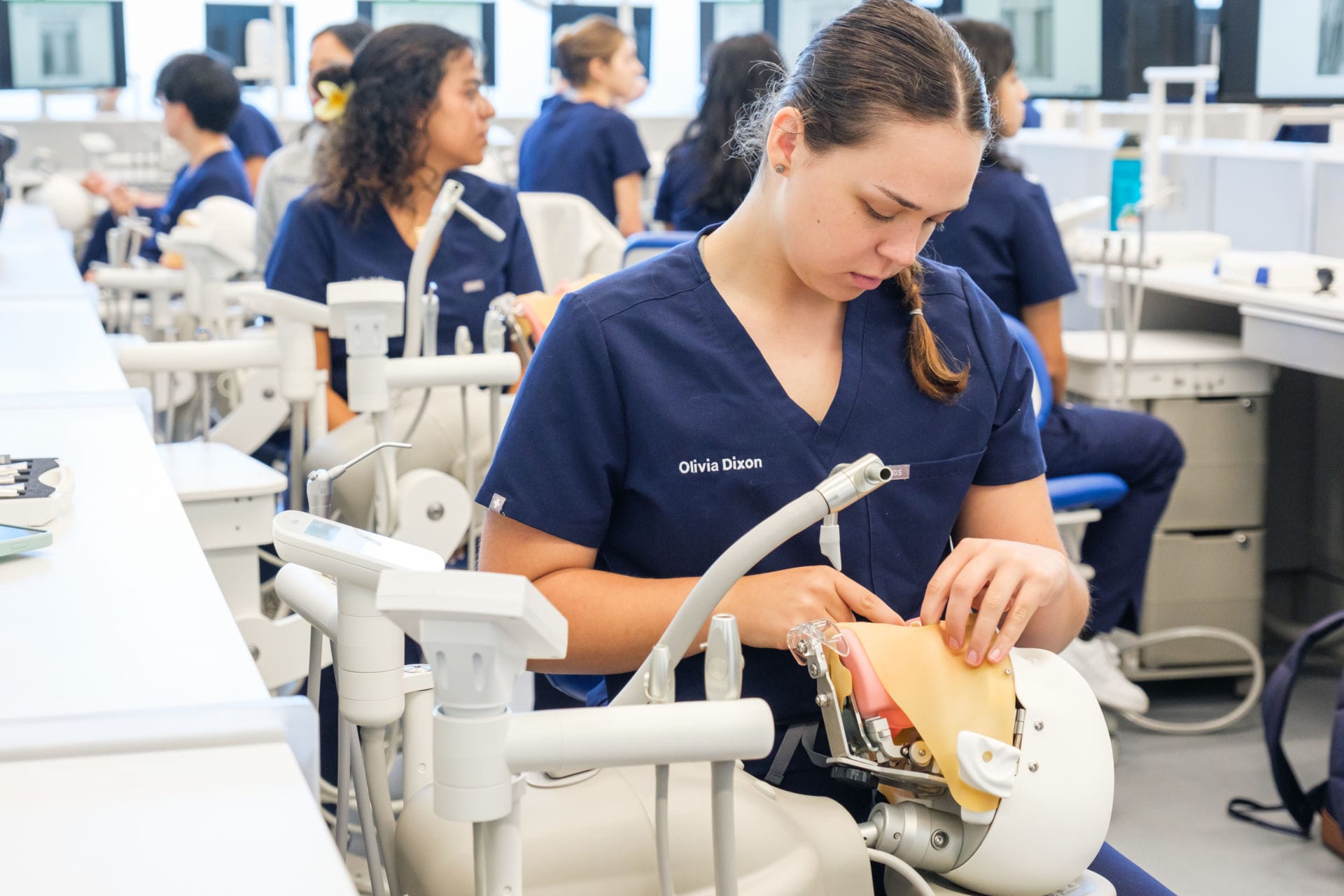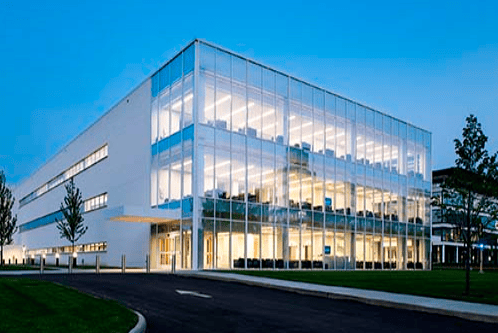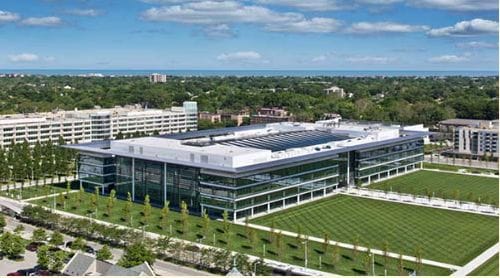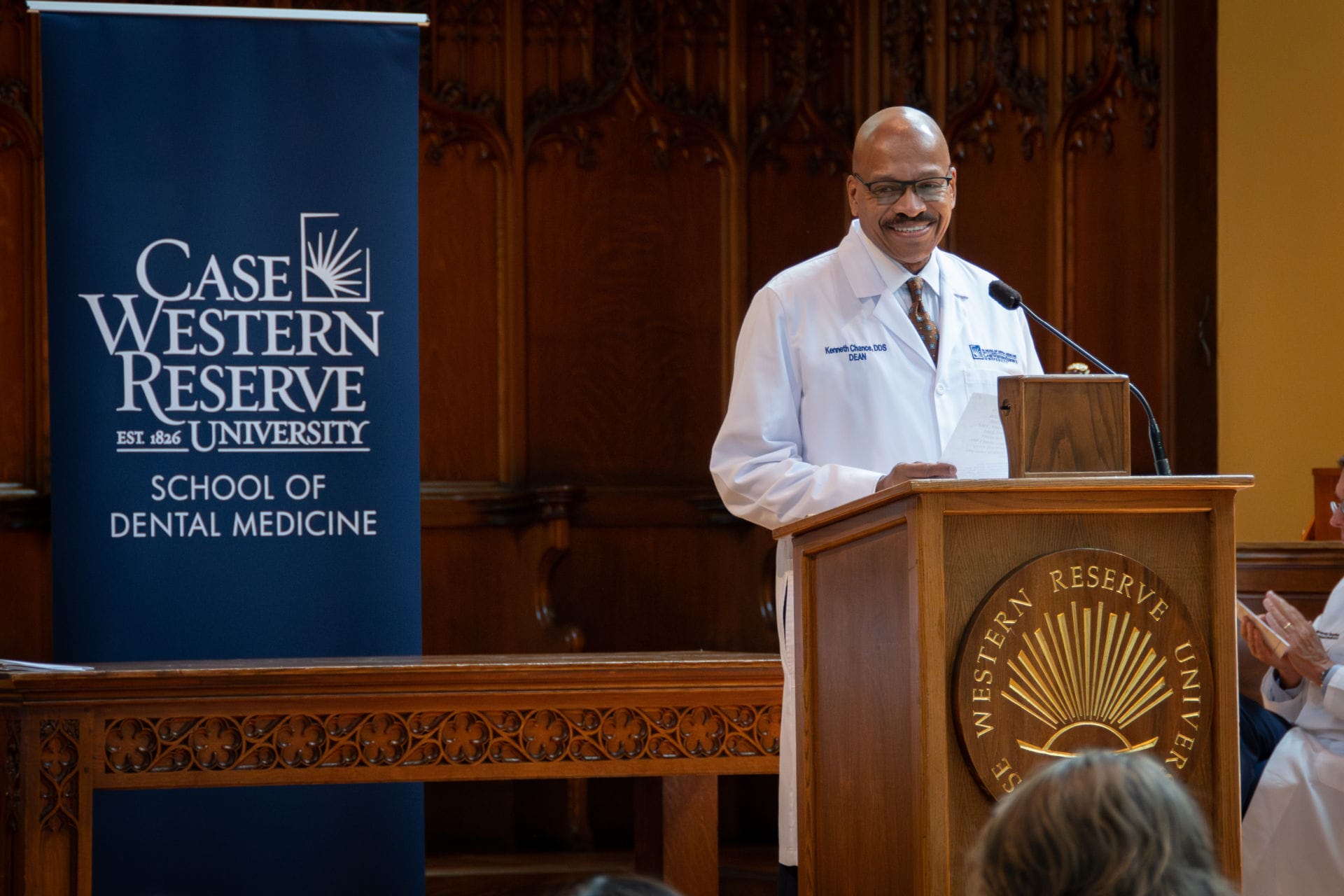WHAT’S NEW AT CASE WESTERN’S SCHOOL OF DENTAL MEDICINE? AN INTERVIEW WITH DEAN KENNETH CHANCE

Case Western Reserve School of Dental Medicine’s newly renovated $2.6 million simulation clinic features Adec simulators, operating lights and doctor’s stools, Bien Air MX2 electric handpieces, Darwin Manikin Systems and 700 Series typodonts, that mirror patient care ergonomics and settings in its clinic operatories.
Dean Chance talks with the ODA Today about CWRU’s innovative Health Education Campus, community outreach initiatives to provide dental care throughout the community, and gives an update on the school’s research initiatives, student body and more.
Q: It has been a few years now since the Case Western Reserve University School of Dental Medicine opened its new clinic and moved the rest of its educational space into the Sheila and Eric Samson Pavilion. Please share how it is going in these new state-of-the-art facilities.
A: In 2019, the Case Western Reserve University School of Dental Medicine (SODM), School of Medicine, Frances Payne Bolton School of Nursing, and Cleveland Clinic Learner College of Medicine moved in the Samson Pavilion, a 477,000 sq. ft. structure, and SODM in the dental clinic on the Health Education Campus. We are the only university in the country that has four health science focused schools under one roof. Our educational programs are vibrant and strong, reflecting major developments and improvements in our curriculum, with comprehensive curriculum reviews, new qualitative and RVU based comprehensive care clinical grading rubrics and electronic grading systems, analytics and student dashboards. In the Samson Pavilion, our newly renovated $2.6 million simulation clinic features Adec simulators, operating lights and doctor’s stools, Bien Air MX2 electric handpieces, Darwin Manikin Systems and 700 Series typodonts, that mirror patient care ergonomics and settings in our clinic operatories. It is the most advanced space in the country. The acquisition and use of the latest digital technologies include, Mixed Reality HoloAnatomy, HoloNeuro incorporated into the predoctoral anatomy curriculum and “Jaws at Work,” used in masticatory dynamics classes. We are the first dental school in the country to use this technology. We also have SimX virtual reality stereotactic navigation simulators to help students strengthen their handpiece skills in restorative dentistry. Interprofessional Education and Collaborative Practice are key elements of the school’s curriculum and clinical education with the other schools, like the Mandel School of Applied Social Sciences. Health professions students take the team-based Collaboration Practice courses together, developing the teamwork skills and encouraging the communication and collaboration required today in health care education and practice. The school’s 132,000 square-foot dental clinic located directly across from the Samson Pavilion features 225 state-of-the-art patient care operatories, to continue and increase our strengths, providing health care to the community. The dental clinic is equipped with the latest equipment and digital technology, including a Yomi robotic implant surgery unit and an Ambulatory Surgery Center with two hospital size operating rooms and postoperative recovery facility designed to care for special needs and medically complex patients.

Case Western Reserve University’s Dental Clinic.

CWRU’s Samson Pavilion houses the School of Dental Medicine, School of Medicine, Frances Payne Bolton School of Nursing, and Cleveland Clinic Learner College of Medicine.
Q: Last year, the School of Dental Medicine released its strategic plan entitled “The Business of Dental Education.” Please tell us about the plan and how it will impact the School of Dental Medicine.
A: The Business of Dental Education is the title and theme for our Strategic Plan. It represents what the dental school means by our mission, purpose and passion for educating dental students and residents, providing ethical, quality, evidence based, collaborative and compassionate patient care, advancing research and discovery, using and applying innovative educational and clinical technology, and serving our community for the purpose of serving humanity to make a difference in and improve the quality of people’s lives, which is the core of who we are and everything we do. Our people are our strength – and we support and value everyone on our team. Our strategic objectives reflect this through faculty and staff development, our school-wide strengths in diversity and inclusion, teamwork and professionalism initiatives. In addition, ethical, compassionate business principles and practices are used to create an infrastructure that supports the mission, vision and values of the school.
Q: What would you say is the biggest challenge facing dental education in general and/or the Case Western Reserve University School of Dental Medicine specifically?
A: I think one of the biggest challenges, if not the biggest challenge facing dental education in general is the high cost of dental education. To address that issue, earlier this spring, American Dental Association (ADA) President Linda J. Edgar appointed me to serve on the National Task Force on Lowering Dental School Tuition as one of four deans selected for the 10-member team. The ADA Board of Trustees formed the task force to address this crucial issue for the future of oral healthcare. The Task Force has met several times and at this year’s Summer Dean’s Institute meeting, participants were surveyed and the issue discussed. A preliminary report is scheduled for the ADA Board shortly.
Q: We continue to hear about the high quality of the candidates applying to dental schools these days, especially at the Case Western Reserve University School of Dental Medicine. Can you share a snapshot of your student body makeup (background, academic credentials, etc.)?
A: Our incoming dental students are highly qualified. The Class of 2028 has an average GPA of 3.70, an average science GPA of 3.63, average DAT AA of 21.46, and an average DAT PAT of 20.71. There are 80 students, 44 females and 36 males. The Class of 2028 comes from 16 different states with 22 from Ohio. We also have 19 international students from Canada, China, South Korea, Taiwan and Vietnam.
Q: The School of Dental Medicine has demonstrated a real commitment to community outreach. Please share a bit about how the School is providing valuable oral health services to the Cleveland community.

Case Western Reserve University School of Dental Medicine Dean Kenneth Chance.
A: The Case Western Reserve University School of Dental Medicine (CWRU SODM) is considered the face of CWRU in the community. Committed to providing services to the community, CWRU SODM dental students travel to Cleveland Metropolitan schools several times per week to provide sealants to young students in the Healthy Smiles program. This is the 21st year that CWRU SODM has provided these services to all schools in the district. To date the program has served and improved the oral health of over 275,000 school age children. In early November 2023, the school returned to its annual tradition of hosting Give Kids A Smile Day and made travel arrangements for 150 students from the East Cleveland School District to be transported to the dental clinic for exams and cleanings. The event is a collaboration with the Greater Cleveland Dental Society. The school also works with University Hospitals Rainbow Babies & Children’s Hospital to operate the Ronald McDonald Care Mobile dental van that provides dental care to children ages 3 to 18 years old in Head Start programs, schools and clinics. The school’s Lifelong Smiles Program uses a mobile van to provide dental care to seniors in nursing and assisted-living centers. All dental students participate in the school’s Geriatric Dentistry rotation. Dental students also completed 62,000 patient visits in the CWRU Dental Clinic in 2023.
Q: Is there anything else you would like to share with our readers about the School of Dental Medicine?
A: Our research enterprise focuses on two pivotal areas of research in Oral Microbiology and Immunology, and Oral Health Disparities and Health Services research. These two focus areas have been well established over the last several years through extramural funding, capitalizing on the links between oral health and overall health. The faculty’s scholarly activity, productivity and publications is a distinct strength, along with student research participation and faculty research mentoring activity with presentations and recognition at state and national meetings.
